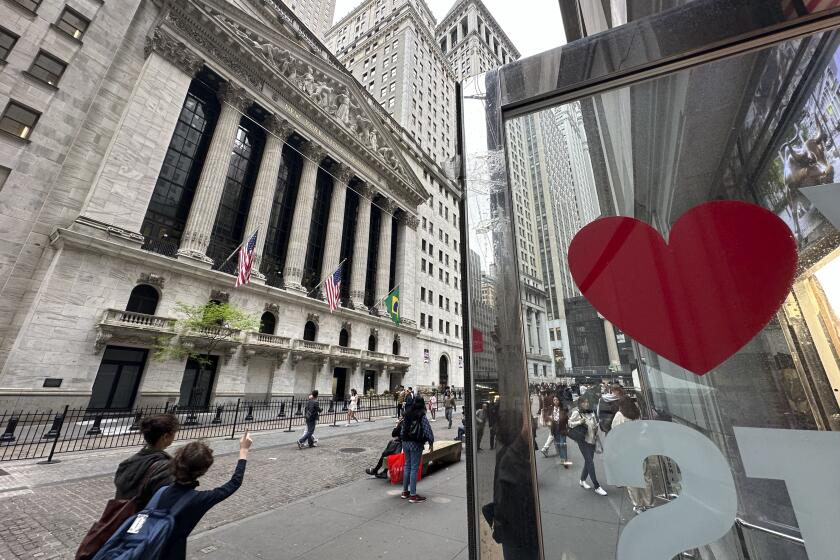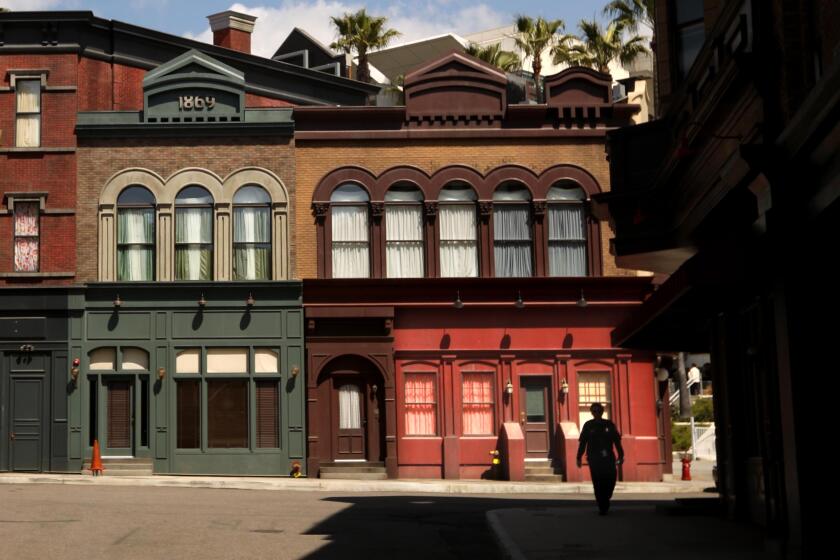ADVERTISING & MARKETING : Family-Style Restaurants Remodel to Appeal to a Wider Variety of Tastes
There was a time when Long Beach resident Mark Niggle wouldn’t eat at a Mimi’s Cafe, no matter how much he liked the food. The problem: The restaurant’s decor was just too feminine.
“The first time my girlfriend brought me in here, I laughed because it was so girlie, kind of frilly,” the tattooed 23-year-old said after eating lunch at Mimi’s Costa Mesa eatery on a recent weekday afternoon.
But no more.
The Tustin-based chain, which has 42 restaurants in four states, has replaced its signature pastels with a look modeled after a French bistro--a look that has been attracting more male customers than ever before.
Mimi’s has plenty of company in the remodeling department. Two other family-style chains, Irvine-based Coco’s and South Carolina-based Denny’s, also are overhauling their eateries in an attempt to broaden their appeal. Such make-overs, which often are accompanied by changes on the menu, are becoming standard for family-style restaurants. They are getting squeezed by fast-food restaurants on price and convenience, and by casual-dining chains such as TGI Fridays and Chili’s, which offer a more lively and entertaining atmosphere.
Profits in the family-style dining segment rose 3.7% in 1998, compared with a 5.2% gain in the fast-food category, and an 8.7% increase in the casual dining sector, according to Technomic Inc., a Chicago-based food industry consultant.
“This is the classic situation of being stuck in the middle,” Technomic President Ron Paul said. “Family-style players are good for breakfast and OK for lunch if you’ve got the time. But they don’t offer the same experience and energy for dinner as the Fridays, the Chili’s and the Houston’s.”
Coco’s and Denny’s, which are owned by South Carolina-based Advantica Restaurant Group Inc., also are trying to appeal to more customers, particularly younger ones. Coco’s is taking a more traditional approach, freshening its interior and exterior color schemes and updating its name to Coco’s Cafe & Bakery. Denny’s is taking a more radical road, remaking its coffee shops into a diner motif. It also is tinkering with its name.
Coco’s could use a boost because the chain has been struggling. Operating income fell 30% in the six months ended June 30, as revenue fell 14.5%.
The chain, which is celebrating its 50th anniversary this year, is spending about $325,000 on each of its 150 company-owned eateries in a three-year, $48.7-million program to liven up its image. Outside, that means doing away with its passive peach-and-teal color scheme in favor of a more modern look featuring stones.
The inside of the restaurants also will drop the peach-and-teal look for more homey earth tones. The goal is to create a “comfortable, yet contemporary ambience,” said Rosemary Doody, Coco’s marketing director.
Coco’s customers will be greeted by a new service counter where they can buy beverages such as cappuccino, Latte and cafe mocha and new bakery items like biscotti and scones. There also is an expanded menu that includes dishes such as Thai chicken fettuccine, Cajun Ahi Caesar salad, tortilla Cobb salad and vegetable lasagna.
So far, six Southland Coco’s have been converted into cafes--three in Los Angeles County and three in San Diego County. Company officials hope to complete the renovations by 2001.
Changing decor is something that restaurants need to do every five to seven years, said Janet Lowder, president of Restaurant Management Consultants of Rancho Palos Verdes. The key, she said, is to make new customers comfortable without alienating the loyal customer base.
Denny’s, the nation’s largest full-service restaurant chain with 1,700 outlets, is going with a ‘50s themed make-over that includes jukeboxes, stainless steel accents and neon lighting. Along with the new theme comes a new name: Denny’s Diner.
Denny’s is spending up to $280 million on a six-year campaign to upgrade its 935 company-owned restaurants. The chain hopes to remodel 150 eateries a year, at a cost of $250,000 to $300,000 each.
The plan is already paying off. Remodeled restaurants saw a 14% jump in sales in the second quarter, while traditional Denny’s saw sales improve 4.1%.
Besides the new name and new signs, stainless steel will be the focal point of the remake. There will be stainless steel accents on the roof and windows, stainless steel front doors, and a stainless steel counter. A jukebox, neon lighting and two color schemes round out the interior changes.
In addition to Denny’s existing menu, the diners will offer “comfort food” such as turkey, meatloaf and pot roast open-faced sandwiches. “In test markets, we found out that the diner theme appealed to customers of all ages,” said Denny’s spokeswoman Debbie Atkins.
The transformation of Mimi’s Cafe has been more subtle. When Mimi’s debuted more than 20 years ago, the restaurants were a cross between Parisian cafes and eateries in New Orleans’ French Quarter.
“We used lots of pinks and pastels,” said Mimi’s President and Chief Executive Thomas Simms. “It was a look that may not be feminine in Europe or in big hotels, but we were dealing with a more casual theme [here].”
Company officials learned that men weren’t comfortable with the Mimi’s look, so as the chain expands, it is spending $6.3 million--about $150,000 per restaurant--to take on a decidedly less feminine look.
The once pink-and-blue walls now are painted in earthy tones that have red and gold hues. Dusty rose tablecloths have been replaced by ones with black-and-white or green-and-white checks. The chain also has added more brick and tile on the walls, wooden beams overhead and antique stone on the floors.
The new image also extends to the menus. The old ones had a French theme with a picture of a woman on the front along with umbrellas. The new menus depict a cafe setting with drawings of people having a good time. Large burgers are now on the menu in addition to old favorites like French onion soup.
Mimi’s is privately held and doesn’t disclose sales or profit data. Simms said the remake has resulted in a 10% increase in sales at restaurants open at least a year. Sales at new restaurants featuring the new look are running 20% higher than the companywide average, Simms said.
“It’s still very female-friendly, but the good news is that we didn’t lose any women and we gained a whole bunch of men,” he said.






